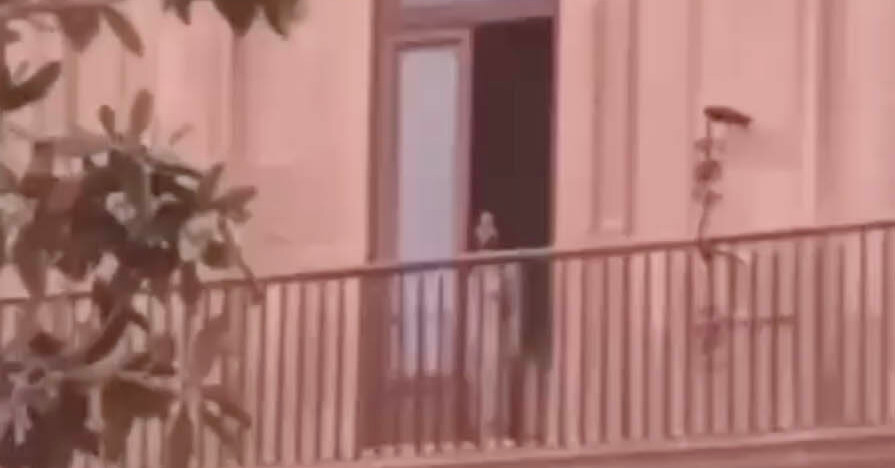Copyright The New York Times

The figure caught on video through the window of a historic government building appeared to be a woman. Some said that she was naked, others that she wore a light robe. From her second-story height, she looked briefly at the protesters outside, one pointing a cellphone camera toward her, and then walked into the dark and out of sight. The footage, taken this April during a teachers’ protest over wages in the main square of San Luis Potosí, a city in central Mexico, shot around the internet and raised all the obvious questions. Who was this person? Why would she be dressed, or undressed, like that in a state government building? And did she have anything to do with the governor or another state employee? The governor’s suggestion drew only more attention: It could be the ghost of Charlotte, the only empress of Mexico, a woman whose short and turbulent 19th-century reign has transformed her into the legendary figure known as Carlota. His remarks drew national attention to the mystery, as well as jokes, skepticism and criticism of the governor, who has been accused of trying to divert the focus from the teacher protests, his government’s spending and other issues. It even drew a brief comment from President Claudia Sheinbaum: “We must always respect public spaces, especially historic sites.” Months later, the questions around the figure in the window remain unresolved. No one has come forward as the person, nor publicly identified them. There were hundreds of teachers protesting that day, and it was not clear exactly who recorded the footage, although both the teacher and the governor said it was a protester. But this week, ahead of Halloween and the Day of the Dead, the governor, Ricardo Gallardo Cardona, agreed to let New York Times journalists into the government building and to elaborate on his investigation. “At first we thought, ‘Could it be someone who is alive and is posing in a robe during those hours?’” Mr. Gallardo Cardona, 44, said in an interview. He added that the state’s security team used video-enhancing technology, normally used to read distant license plates, to zoom in on the blurry figure, hoping to determine if it was a government employee. “You can’t see the face,” he said, adding that the person recording had been streaming on Facebook Live at the time. The governor’s staff also checked the cameras of the government building. The unused room in question has several windows facing the main square, a staircase leading down to a legal office, and a door, usually locked, connecting to an auditorium. But the cameras showed no one entering or leaving that area, Mr. Gallardo Cardona said. How then, did he come to the idea of a ghost? “For the workers there, it’s very common to see things upstairs, to hear noises,” the governor said, adding that a woman was among their reported sightings. Mr. Gallardo Cardona said that he usually worked from another building — and that he was out of town on the day in question — but that he also does not like being in the building late. “When I’ve been working upstairs, I hear a lot of noise from the other side of the hall,” he said. Empress Charlotte does not appear to have any historical connection to the government building, and the governor conceded that his history might have been muddled. Charlotte was a Belgian royal who married Maximilian, an Austrian archduke who Napoleon III named the emperor of Mexico in 1864, after the French invasion. The empress lived in Mexico for only two years, none in San Luis Potosí. But Charlotte looms large despite her brief role in Mexican history, said Erika Pani, a history professor at the College of Mexico. Even though she and Maximilian symbolized European imperialism to some in Mexico, Ms. Pani said, Charlotte became known as a tragic figure because of her initial idealism about ruling Mexico, the execution of her husband and for living with mental illness at a young age. Long after her death in Belgium in 1927, Charlotte has been widely depicted in popular culture, from plays to movies. “The tragic is what invites people to think that she didn’t rest, and they consider her to be a restless soul,” Ms. Pani said. Others admitted they believed in ghosts, but perhaps not this time. Bernabe Ávila Ramírez, 69, who has been shining shoes in the main square for more than five decades, said maybe the figure was a real woman or an optical illusion. But, he said, government workers had told him they have heard unsettling noises at night in the building. “I do believe in the supernatural because I’ve experienced it,” he said. “I’ve always lived here in the main square or around it. They’re old houses, very large.” Mr. Gallardo Cardona said he understood people’s skepticism. He also did not believe in ghosts per se but rather “energies,” he said, adding that he was told that his late grandfather’s energy remained in his grandparents’ home. And he considered his state an especially spiritual place. “Here, the mysticism of the Day of the Dead encompasses legends and it encompasses many things that for many were true and others were not,” he said. “In U.S. culture, Halloween isn’t real. It’s a culture of consumerism, candy, costumes, buying Freddy Krueger masks and making more movies.” In April, though, the governor suggested he wanted to be rid of whatever was haunting the palace, real or phantasmal, saying he was considering an exorcism. But this week, he said, profanely, that he had no plans for it. “Because if we do it,” he said, “then they’re going to say, ‘That damn governor is crazy and continues with his nonsense.’”



